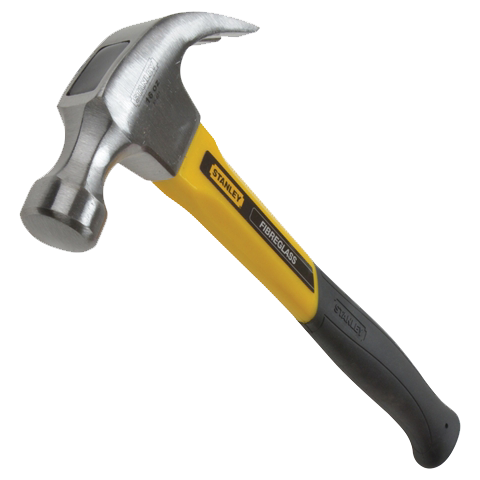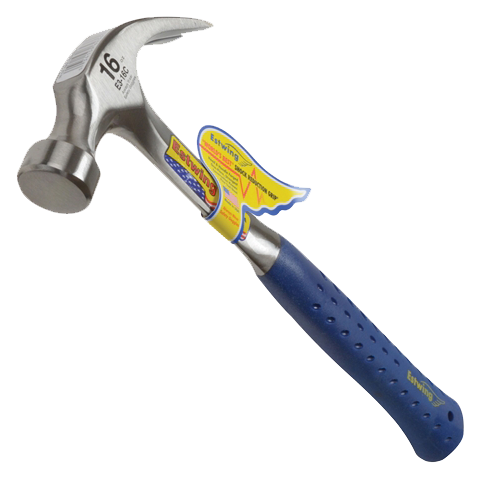
As a follow-up to my recent post regarding all things hammer, I’m writing this article to complement the previous post. This time it’s a comparison of three claw hammers rather than more on the evolution of the hammer which I covered pretty comprehensively in my last post. We’ve chosen three in an attempt to be scientific with our testing.
So, what’s so special about these hammers? Isn’t a hammer, JUST a hammer? Well, yes, it’s a hammer and essentially they’re the same thing; it’s used to hit things with! However (according to experts, designers, trade professionals and the manufacturer) , there are some interesting nuances between the three hammers I’m looking at. The first is a very popular old classic from Estwing, who you will know if you read my other blog post about hammers has been making hammers since 1923, their E3 claw hammer being one of the most popular hammers for professionals all over the planet. The second hammer I’ll be looking at is a new innovative design by Vaughan, an American company that’s been making hammers since 1869; it’s their Dalluge style straight claw titanium hammer! And finally our control or baseline for a reasonable everyday hammer, so I chose the Stanley 51-621 hammer created with a fibreglass handle to reduce vibration.
So let’s look at the three and their attributes.
The Stanley hammer 51-621

The heat treated forged high carbon steel curved claw head is fully polished and rim tempered for durability and safety.
The fibreglass handle absorbs shock and vibration and the textured rubber ensures a comfortable, secure grip.
High visibility yellow makes the hammer safe and easy-to-locate in work areas.
So, basically an everyday and cheap hammer, for around £12 inc VAT at your local shop or online. Not pretty to look at with a rubber grip and fibreglass handle that in reality does little to cushion the blows you land. Yes, it’s better than cheaper hammers, a little. But it doesn’t really match up to the other two. So this is our baseline hammer, everyone at home has something of this quality or slightly better.
The Estwing hammer E3/16

The Estwing E3 series curved claw hammers have a vinyl grip made from liquid vinyl bonded on to the shaft during production, offers the utmost in both comfort and durability, while reducing vibrations caused by impact.
The conventional carpenters’ curved claw hammer offers unsurpassed balance and temper.
Made in the USA from high quality steel.
As I’ve already said earlier, the Estwing E3 claw hammer is the go to tool of the professional, the workhorse of the construction site for the carpentry teams. The steel shaft goes the length of the hammer with the vinyl handle molded around it to create the soft handle. This hammer would set you back around £50! I’ve known carpenters who have their Estwing hammer for 20 years.
The Vaughan “Dalluge” style straight claw hammer

Weight: (16 oz.).
Handle length: 430mm (17 inch)
The lightweight DDT 16, with its patented deep “V” head design, provides faster, greater power at point of impact with less stress and arm fatigue.
The DDT 16 hammer features a patented titanium head with overstrike guard. It’s exclusive Double “D”™ Magnetic Nail Holder has the ability to hold both standard and duplex nails and provides increased reach for one-handed nail starting, while the Sidewinder™ Nail Puller provides extra leverage for removing nails without ripping up forms. For fast and easy tear downs and rip outs the Short Stack™ Claws on the DDT 16 hammer are reinforced to provide increased strength for prying. Heads made in China. Handles made in USA. Assembled in USA. MADE IN CHINA
So Titanium hammers have been around for a while now. You will get this Vaughan hammer from the internet or if you’re very lucky from a shop but it will set you back £220!! So it makes sense that you’d want to check it out before you put that kind of money into buying this hammer. Why does it cost 4 times the price of a regular high quality claw hammer and, what would it take to convince anyone to pay this much money for it?
The good, the bad and the not so bad…
In a direct comparison between the three hammers.
The Stanley is cheap, it’s rubber grip isn’t great but is usable, the fibreglass, anti-vibe handle doesn’t stop the softer vibrations and I suppose would do if you had nothing else to use. When we decided to do this test, we did think about using some kind of kenetic testing equipment to compare the impact force and the vibration carried back down the handle, but this equipment is really expensive and we decided against it. In the end the hammer is heavy and unforgiving. At around 10 nail mark your arms starts really feeling it, and honestly you want to take continue much longer…
The Estwing is heavy like the Stanley, but the handle feels much better in your hand. There’s a certain amount of anti-vibe through the vinyl grip but not much. It’s heavy but it hits nails perfectly, and once again is unforgiving in the long run. Around the continuous 10 nail mark again, your arm starts feeling it. It’s better with vibration than the Stanley.
The Titanium Vaughan hammer is much lighter, and the wooden handle helps with vibration, so lots of anti-vibe characteristics. So light you don’t feel any strain from hitting in 20 nails continuously!
So the bottom line? To me the titanium hammer isn’t just a fad, it does help with it’s weight and you won’t suffer from a sore wrist afterwards; or will need to nail twice to three times as many nails as the steel hammer to get the same effect. Saying this, the price IS a down side, so the titanium hammer is really just for the professional who works all day at hammering or a dedicated DIYer who doesn’t mind paying out the high price! But for most serious professionals it’s the trusty Estwing!
If you’re interested in trying and buying any of these three hammers here’s a link to each.
Stanley glassfibre hammer 51-621 hammer – £11.94 inc VAT
Estwing E3/16C Vinyl grip hammer – £49.26 inc VAT
Vaughan ‘Dalluge’ Style Straight Claw Titanium Hammer – £220.96 inc VAT

This article will help beginners to learn about various hammers. I have a buddy who’s just beginning his DIY projects, and I will share this article with him.
I could not refrain from commenting. Perfectly written!
I am really impressed with your writing skills and also with the layout on your blog.
Is this a paid theme or did you customize it yourself?
Either way keep up the nice quality writing, it’s rare to see a great
blog like this one nowadays.
I like the helpful info you provide in your articles.
I will bookmark your blog and check again here regularly.
I am quite sure I will learn many new stuff right here!
Best of luck for the next!
A round of applause for your article. Much thanks again.